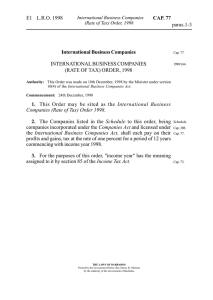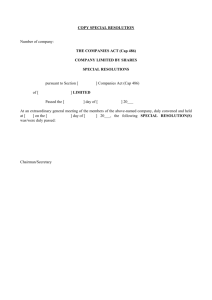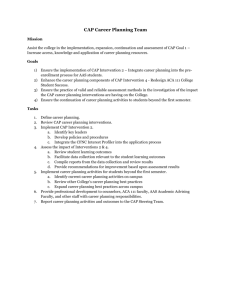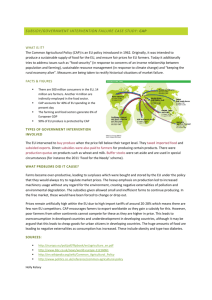CAP life
advertisement
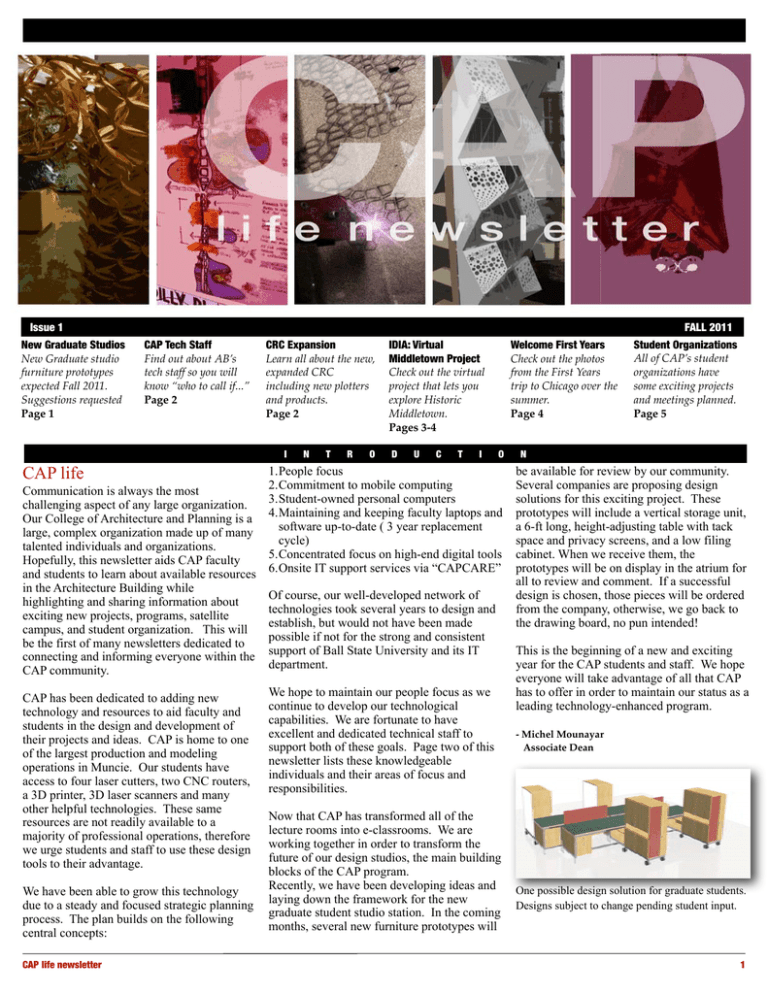
Issue 1 New Graduate Studios New Graduate studio furniture prototypes expected Fall 2011. Suggestions requested Page 1 FALL 2011 CAP Tech Staff Find out about AB’s tech staff so you will know “who to call if...” Page 2 CRC Expansion Learn all about the new, expanded CRC including new plotters and products. Page 2 I N T R O Welcome First Years Check out the photos from the First Years trip to Chicago over the summer. Page 4 IDIA: Virtual Middletown Project Check out the virtual project that lets you explore Historic Middletown. Pages 3-4 D U C T I O 1.People focus CAP life 2.Commitment to mobile computing Communication is always the most 3.Student-owned personal computers challenging aspect of any large organization. Our College of Architecture and Planning is a 4.Maintaining and keeping faculty laptops and software up-to-date ( 3 year replacement large, complex organization made up of many cycle) talented individuals and organizations. 5.Concentrated focus on high-end digital tools Hopefully, this newsletter aids CAP faculty 6.Onsite IT support services via “CAPCARE” and students to learn about available resources in the Architecture Building while Of course, our well-developed network of highlighting and sharing information about technologies took several years to design and exciting new projects, programs, satellite establish, but would not have been made campus, and student organization. This will possible if not for the strong and consistent be the first of many newsletters dedicated to connecting and informing everyone within the support of Ball State University and its IT department. CAP community. CAP has been dedicated to adding new technology and resources to aid faculty and students in the design and development of their projects and ideas. CAP is home to one of the largest production and modeling operations in Muncie. Our students have access to four laser cutters, two CNC routers, a 3D printer, 3D laser scanners and many other helpful technologies. These same resources are not readily available to a majority of professional operations, therefore we urge students and staff to use these design tools to their advantage. We have been able to grow this technology due to a steady and focused strategic planning process. The plan builds on the following central concepts: CAP life newsletter We hope to maintain our people focus as we continue to develop our technological capabilities. We are fortunate to have excellent and dedicated technical staff to support both of these goals. Page two of this newsletter lists these knowledgeable individuals and their areas of focus and responsibilities. Now that CAP has transformed all of the lecture rooms into e-classrooms. We are working together in order to transform the future of our design studios, the main building blocks of the CAP program. Recently, we have been developing ideas and laying down the framework for the new graduate student studio station. In the coming months, several new furniture prototypes will Student Organizations All of CAP’s student organizations have some exciting projects and meetings planned. Page 5 N be available for review by our community. Several companies are proposing design solutions for this exciting project. These prototypes will include a vertical storage unit, a 6-ft long, height-adjusting table with tack space and privacy screens, and a low filing cabinet. When we receive them, the prototypes will be on display in the atrium for all to review and comment. If a successful design is chosen, those pieces will be ordered from the company, otherwise, we go back to the drawing board, no pun intended! This is the beginning of a new and exciting year for the CAP students and staff. We hope everyone will take advantage of all that CAP has to offer in order to maintain our status as a leading technology-enhanced program. - Michel Mounayar Associate Dean One possible design solution for graduate students. Designs subject to change pending student input. 1 F A C I Technology in CAP Who can I call for Facilities and Tech support at CAP? CAP has several staff members in charge of the building facilities and technology. Their goal is to facilitate the educational, service, and research mission of the university and the college. The tech staff works as an experienced and talented team, however, each individual has specific areas of specialization. For classroom technology including help with projectors, AV equipment, or web conferencing the person to contact is Chris Helms (5-4612, AB 007) Chris also is our resident photographer and helps us with the many publications produced via the dean’s office. Chris can also post photos from projects or field trips or information about upcoming meetings on the marquee screens located on the first floor. For computer related support please call the Technology Help Desk at 285-1517. Your request will be logged and sent to the appropriate IT support staff. In most cases such a call will land on Roger Whitted’s desk (5-5855, AB 022). Roger is extremely knowledgeable and helpful with computer issues. Chris Helms may also lend a hand for Mac users. Students and faculty members are also encouraged to visit capCARE for even more computer support. Four graduate assistants with computer knowledge are available to help with all your computer needs. capCARE is conveniently located in the CRC. The schedule for the fall semester is: -Monday: 8am-6pm - Tuesday 9:30-10:30 am and 3:30-7:00 pm - Wednesday- 8am-6pm - Thursday 8-10:30 am and 3:30-7:00 pm - Friday: 8 am-2:30 pm For more information about capCARE, please contact Chris Helms. 2 L I T I E S / T E C H N For questions relating to the Architecture Building itself, including building security, elevators, temperature, water, electrical, available equipment or furniture, card access to rooms or studios Bart Amburn is the man with the keys! (5-9168, AB 006) Bart also comes with considerable experience in the area of extended education, telecommunication, web conferencing, polycom, audio visual equipment. Bart manages the CRC and is open to new suggestions about new products and services. If you are planning to use the FABLAB, any of CAP’s Shops, or just need to borrow a screwdriver to install your parallel bars, the person to seek is Kyle Sechrest (5-5864, AB 029). Kyle has extensive experience in scenery design and production. Though this will only be his third year here at CAP, Kyle has already morphed the FABLAB to better serve both faculty and students. The FABLAB has many tools to help students create just about anything they can think up. The shop will also rent out tools anyone might need for any studio project. Kyle urges all students and faculty down to see the new FABLAB addition! CAP is committed to both traditional and digital fabrication technologies. CAP also supports design/build and the exploration of materials as one of the essential learning opportunity for its students. Our challenge continues to be our limited space for construction experimentation. We are trying to avoid the use of corridors for such purposes. So for safety concerns please strictly no construction work, painting, or use of tools in studios or other open public areas. Using CAP’s facilities wisely and safely will help reduce building wear and tear and will help prolong the life of the technology in CAP. Please contact Chris, Roger, Bart, or Kyle with any questions or issues you might experience in CAP. Introducing the NEW FABLAB Computer Numerical Cutting The new AB addition is now complete and fully operational. The CAP community is O L O G Y grateful to CMD for sponsoring the new CNC space. The new facility houses two CNC routers available to both Faculty and students. These machines also supports the work of the Institute for Digital Fabrication (IDF) an important knowledge unit of our college. Another new addition to the FABLAB traditional area is a new, safer table saw (SAW STOP) specially designed to prevent injury or dismemberment. Visit Kyle Sechrest and review all the new aspects of both the traditional or digital sides of our shops. The Fab Lab is accessible to all faculty and students. Contact Kyle for an appointment today! Pardon Our Mess... The CRC is being redesigned to become more efficient and spacious! Anticipated completion Fall 2011. The CRC just added two new plotters which should assist our students with the production of high end printed material. One of the four photographic qua lity plotters will be set a side and dedicated to single sheet fed art paper. The CRC also features two production quality printers as well. This new setup will allow students to use approved watercolor, mylar, or vellum for their artwork and presentations. In addition to the plotters, a new counter is being built to streamline the operation and add to the selection of graphic and model building supplies. The CRC will also be expanding the food selection with the addition of a new freezer! During its remodeling, the CRC will continue to be a hub of activity and a support center for our students and college. For ideas on better service and selection, the CRC wants to hear from you. For any suggestions you may have please email Bart Amburn. CAP life newsletter E CAP $300 Faculty IT Support CAP Faculty IT Currency Program is still available for 2011-12 Academic Year CAP offers full time faculty the opportunity to be reimbursed for digital tools or equipment up to $300. In the past, faculty used this funding to buy laser pointers, remote controls, printers, digital cameras, scanners, software, or in some cases printing supplies. This program is intended to assist faculty with their digital needs. Deadline for reimbursement is April 15th, 2012. Please consult with Melanie Smith prior to completing your purchase. Please note: 3G Ipads, PDAs or phones do not qualify. Digital Storage Space CAPSTORAGE is a secure departmental server setup to offer faculty a digital repository. Each department has 2T of space that has been made available to faculty. One particular part of this digital storage is dedicated as a common space for all faculty to access and share documents. We dub it the “CAPSANDBOX”. For information on how to access this server please contact your department for information about departmental CAPSTORAGE personnel. The CAP Faculty Guide introduces CAP’s people, many departments, resources , or programs. The guide also gives details about the resources and spaces of the Architecture Building (AB). Please log on to the CAPSTORAGE server at the CAP Sand Box to access this document. M E R G I N G M E D implication of size, light, and sequence in a physical model. These new tools may be checked out to faculty and students from the Simlab via Chris Helms. I A IDIA: Institute for Digital Intermedia Arts IDF: Institute of Digital Fabrication Currently, CAP students Hank Mezza, James Dechant, Andre Haffenden, Zach Grajewski, Christopher Baile, and Steven Putt are designing, fabricating, and installing an interior fit-out for the Center for Media Design as Digital Fabrication Student Immersive Fellows. Under the supervision of Joshua Vermillion and Kyle Sechrest, the project is scheduled for completion in December. Currently, custom designed and fabricated furniture is being installed in phases. IDIA published the Virtual Middletown project in Blue Mars. This project will be featured in the Edge Magazine – a UK virtual world, gaming and simulation print and web publication. The Virtual Middletown Project brings to life the 1929 and 1937 Lynd Study of IDF is also working on a “Transformer” Middletown America through the virtual project. The “Transformer” is a shading world of Blue Mars. This prototype recreates lattice that is light responsive and designed by elements of industrial life from that period, an interdisciplinary team of students and specifically the Ball Glass Factory. The faculty. This system can potentially be used project incorporates various modes of as a shading device within a building learning and interaction - while maintaining envelope, the immersive experience. The Virtual completely Middletown Living Museum project in Blue transforming Mars is a simulation of the Ball Glass factory the way we from early 20th century Muncie, Indiana. Life think about and conditions in the factory were one of the shade systems key elements of the Middletown Studies by in architecture. Robert S. and Helen Merrell Lynd in The team, the Middletown (1929) and Middletown in consisting of Transition (1937) studies. These in-depth Xiorelis Cox, accounts of life in Muncie, Indiana, became Geoffrey classic sociological studies and established DeSmit, Andre Clickers at CAP the community as a barometer of social trends Paul in the United States. In the years since, Haffenden, The Clicker technology is being used by our scholars in a variety of fields have returned to and Tianxiao planning department this academic year. Muncie to follow up on the Lynds' work, Peng with Students will have the ability to interact and making this small city among the most faculty leaders participate with their class in real time. The studied communities in the nation. The center Kevin Klinger system is driven by a wireless base made continues this tradition by sponsoring and and Joshua Vermillion, are using prototypes to promoting research on Muncie as available by BSU at no cost to the instructor or the college. Students purchase the clickers complete their designs. The prototypes allow Middletown, on small cities generally, and on them to use scripting and small-scale physical the themes and issues the Lynds explored. from the BSU bookstore or may download computing equipment to actuate mechanical application driven devices to their smart movements while using geometry and phone. Clickers will allow for polling and This simulation of industrial life, built as a patterning to simulate and analyze desired opinion casting during class. prototype for a much larger project dealing lighting scenarios all while fabricating with all aspects of the Lynd Study, has aimed components using the CNC equipment. This to create a virtual living museum experience New Tools for Design: project will be exhibited at ACADIA 2011 expanding the opportunities for both learning Infrared Camera and Model Scope International Conference in October and has and interpretation. The approach to interactive also been selected as a finalist in the design embeds learning and navigation Last year, CAP acquired an Infrared Camera ACADIA | FLATCUT 2011 International experiences subtly into the project to maintain for use with environmental design courses. Design Competition. Their website is http:// the sense of immersion. IDIA has prototyped This camera is capable of detecting heat loss www.i-m-a-d-e.org. several techniques to do this including: by simply reading thermal changes in the interactive objects that allow for close up space or from the object itself. inspection; objects that when clicked bring up Another new tool for design is the Model web resources that show information; plans or Scope. This is a powerful tool to help photographs used in the interpretation; nonstudents and faculty understand the CAP life newsletter 3 I N T E R D E player character factory workers, a live interactive avatar of Frank C. Ball who greets visitors and introduces them to the factory; video and audio files of factory experts and archival films; an in-world interactive HeadsUp-Display (HUD) that provides deeper investigation and navigation through the factory; and a supporting webpage with complete documentation on all resources used in this interpretation. For more information about this project please visit their website: http://idialab.org/ projects/44 IDIA also Partnered with: The Center for Middletown Studies, Library Services and funded by the Emerging Media Initiative at Ball State University P A R T M E N T A L / applicable to the disciplines of urban planning, landscape architecture, and architecture. Students have a full itinerary that included walking tours of the University of Chicago campus courtyards, The Illinois Institute of Technology campus plan, several sites in the Chicago downtown loop, a Wendella river boat tour, A walking tour of Oak Park (a neighborhood that has a history of progressive social diversity as well as sites relevant to Frank Lloyd Wright), a guided tour of Unity Temple, a walking tour of the Lincoln Park historic neighborhood (with several blocks that survived the Chicago fire), and a day at the Chicago Botanic Garden of Glencoe, Illinois, including the Rice Center for Plant Science Studies (rated LEED gold), and several opportunities to study placemaking at the famed Millennium Park. Center for Historic Preservation The Center for Historic Preservation participated in the Indiana State Fair Heritage Day this summer. Volunteers from the Center and the Masters of Historic Preservation program set up a booth with information about the Center for Historic Preservation and its services as well as the importance of Architecture in Indiana’s heritage. Along with handing out facts about CAP, Ball State University, and coloring books with notable Hoosier architectural styles, the volunteers encouraged visitors to play a game of Bag Toss. The game tested skills and knowledge as participants threw bags of corn into holes corresponding with specific architectural styles. Bag Toss was a fun learning experience for the young and old who were taught the importance of the changing face of architecture as a valuable timeline of history. (Pictured) CAP students and faculty view the “Model City” exhibit, a scale model of the Chicago “Loop” central business district, in the lobby of the Santa Fe Building, Chicago, Illinois. Photo by Lohren Deeg. O U T R E A C H Students review each other’s sketches and diagrams during a stop in Oak Park, Illinois. Photo by Lohren Deeg. MUD: Indianapolis Master of Urban Design The third group of MUD students have started their studios at the CAP Indianapolis Center. The class consists of 8 graduate students from multidisciplinary backgrounds including Architecture, Landscape Architecture, and Urban Planning. The group also includes our first international student to join the Indianapolis campus, Mr. Abdullah Alkenaidari from Saudi Arabia. 2011 Summer Workshop for High School Students Students learned about opportunities in LEED-ND (Neighborhood Development) at an exhibit located at the Chicago Architectural Foundation, Santa Fe Building. Photo by Lohren Deeg. MSHP student Emily Weiler explains architectural styles to fair participants learning about history. CAPFY Chicago Field Trip By Lohren Ray Deeg, ASAI, Assistant Professor of Urban Planning The CAP first year field trip to Chicago conducted in the summer semester allowed students to explore a range of issues 4 Students explore testing beds on a green roof installation, Rice Center for Plant Science Studies (LEED-Gold), Chicago Botanic Garden, Glencoe, Illinois. Photo by Lohren Deeg. The CAP summer workshop continues to be an important part of the mission and calling of CAP. This summer, the workshop was recognized with a major grant from the National Endowment for the Arts. The NEA grant helped the program offer scholarship support to several highlyqualified high school students. The workshop curriculum continues to focus on introducing young talent to careers in Architecture, Landscape Architecture, and Urban Planning. The workshop faculty leaders included Professors Joseph Blalock, Vera Adams, CAP life newsletter S T U D Janice Shimizu-Coggeshall. 2011 CAP students and resident assistants (RA’s) are: Heidi Stewart, Taylor Metcalf, Ethan Coverstone, and Rachel Marinelli. AIAS The American Institute of Architecture Students is currently planning a guest lecture series featuring prominent firms in the architecture world. AIAS is also holding several workshops about finding an internship, making a resume and cover letter, and other tips for success. AIAS is excited to attend this year’s Forum in Toronto, Canada where some of their members will be accepting an award for their research in Haiti. AIAS holds their meetings every other Wednesday at 5 in the Atrium. E N T O R G A N I Z In order to welcome the new students properly, ASHP officers and other second year MSHP students volunteered their time over the summer to fully clean their 2nd floor studio. The classroom, which had not been organized in over ten years, was completely taken apart, cleaned and rearranged. The “new” studio space offers a better study and meeting space. The officers also organized several activities and ice breakers for the first week of class. Known as Welcome Week, MSHP students participated in various cookouts, outings, and meetings in order to get acquainted with older students and department faculty. ASHP members are also excited to head, once again, to the National Trust Conference, being held this year in Buffalo, New York. During this annual conference, students get to listen to lectures about topics important to preservation as well as mingle with students and professionals from all over the globe. In order to help fund part of this exciting event, ASHP sells soda and other snacks for 50 cents. See their studio in AB218 whenever you have a craving for something sweet! The next meeting is October 11 at noon in the MSHP studio (AB 218). ASLA AIAS members gather during an Internship Panel meeting where students were given advice on resumes, looking for an internship, and other tips for beginning a successful career. ASHP The Associated Students for Historic Preservation (ASHP) are happy to welcome 8 new members to the Masters of Science in A Historic Preservation (MSHP) class: Catherine Anderson, Elizabet Biggio, Julie Edwards, Kayla Hassett, Cameron Hicks, Britta Resse, Jill Van Gessel and Sarah Robinson. The American Society of Landscape Architects volunteered at the Living Lightly Fair on September 10th. ASLA is also planning on community outreach this fall as well as preforming some landscape projects right on Ball State Campus. ASLA busy planning their fall Apple Fest. On October 22nd, the group is holding a flag football tournament and cookout for the Landscape Architecture Studios. The group meets every-other Wednesday at 4:30 in AB202. T I O N S FBD Freedom By Design, part of AIAS, is a student community service organization that utilizes the talents of CAP’s architecture students to impact the lives of people in the surrounding Muncie Community. The group helps modify and enhance homes of lowincome or disabled individuals by addressing their struggles with everyday tasks. FBD meets every-other Wednesday at 5:00 in the 2nd Floor Atrium. NOMAS The National Organization of Minority Architecture Students (NOMAS) are pleased to announce their involvement in the 2011 NOMA Design Competition. This year, the students are enrolled in a Transit-Oriented Development Project in a Historic AfricanAmerican community in Atlanta, Georgia. NOMAS will be electing delegates to present their final project in Atlanta at the 2011 NOMA Conference October 20th through the 22nd. NOMAS meets every Wednesday at 5:00 in AB310. SLA Sigma Lambda Alpha (SLA) has elected officers for this year: President - Cassandra Rice, Vice President - Nicole Yurich, Treasurer - Jessica Gordon and, Secretary Shannon Creasy. Meeting times have not been scheduled yet. Contact Shannon Creasy for further information. Attention CAP: We want to keep CAP updated on all of your activities! Whether you are an organization, faculty, or even a student, we want to know what you are doing! Field trip week is coming up and we want to know about where you visited and what you did. We want CAP to stay informed about any new and exciting projects for studio or any upcoming events you would like to share with the rest of us. Please email Emily Weiler (eaweiler@bsu.edu) or Lori Pence (lpence@bsu.edu)with any updates and new information. Make sure you also take lots of pictures at your events so you can share it with the rest of the CAP community! College of Architecture and Planning Architecture Building (AB), Room 104 Ball State University Muncie, IN 47306 Phone: 765-285-5859 Fax: 765-285-3726 Email: cap@bsu.edu CAP life newsletter 5
